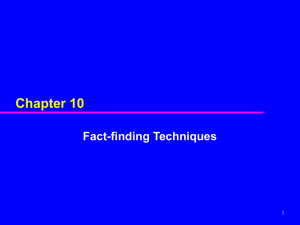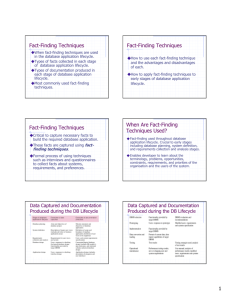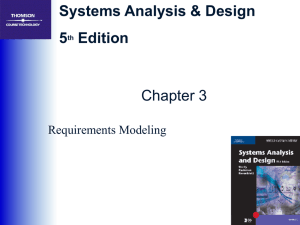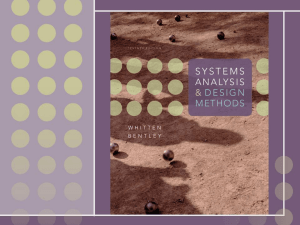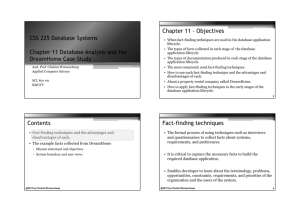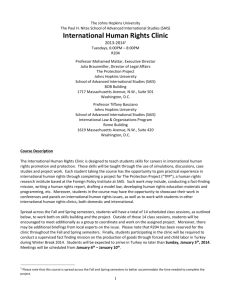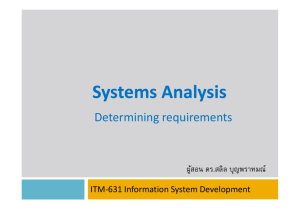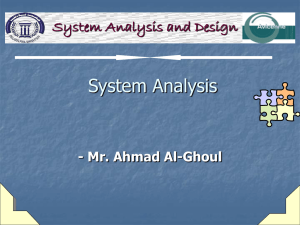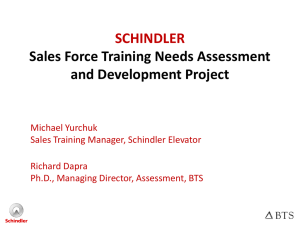Chapter 3 Study Tool
advertisement
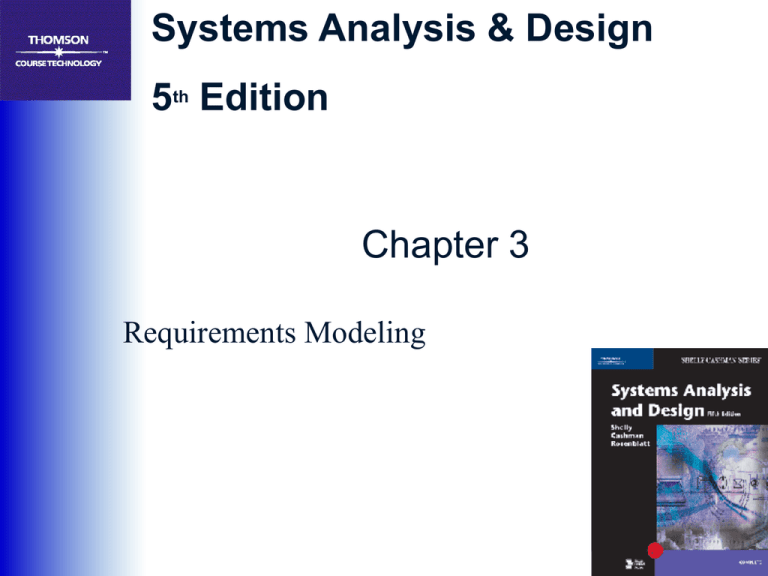
Systems Analysis & Design 5th Edition Chapter 3 Requirements Modeling Phase Description ● Systems analysis is the second of five phases in the systems development life cycle (SDLC) ● Uses requirements modeling and enterprise modeling to represent the new system ● Before proceeding to the next phase, systems design, you will consider system development strategies 2 Introduction ● This chapter describes requirements modeling techniques and team-based methods that systems analysts use to visualize and document new systems ● The chapter then discusses system requirements and fact-finding techniques, which include interviewing, documentation review, observation, surveys and questionnaires, sampling, and research 3 Systems Analysis Phase Overview ● Systems Analysis Skills – Analytical skills – Interpersonal skills ● Team-Oriented Methods and Techniques – Joint application development (JAD) – Rapid application development (RAD) 4 Joint Application Development ● User Involvement – Users have a vital stake in an information system and they should participate fully – Successful systems must be useroriented and users need to be involved 5 Joint Application Development ● JAD Advantages and Disadvantages – More expensive and can be cumbersome – Allows key users to participate effectively – When properly used, JAD can result in a more accurate statement of system requirements, a better understanding of common goals, and a stronger commitment to the success of the new system. 6 Rapid Application Development ● Is a team-based technique that speeds up information systems development and produces a functioning information system ● Relies heavily on prototyping and user involvement ● Project team uses CASE tools to build the prototypes and create a continuous stream of documentation 7 Rapid Application Development ● RAD Objectives – To cut development time and expense by involving the users in every phase of systems development – Successful RAD team must have IT resources, skills, and management support – Helps a development team design a system that requires a highly interactive or complex user interface 8 Rapid Application Development ● RAD Advantages and Disadvantages – Systems can be developed more quickly with significant cost savings – RAD stresses the mechanics of the system itself and does not emphasize the company’s strategic business needs – Might allow less time to develop quality, consistency, and design standards 9 Modeling Tools and Techniques ● Functional Decomposition Diagrams – A top-down representation of business functions and processes – Also called structure charts 10 Modeling Tools and Techniques ● Functional Decomposition Diagrams Figure 3-9 11 Modeling Tools and Techniques ● Unified Modeling Language – A widely used method of visualizing and documenting software systems design – provides various graphical tools and techniques, such as use case diagrams and sequence diagrams 12 Modeling Tools and Techniques ● Unified Modeling Language Figure 3-10 13 Modeling Tools and Techniques ● Unified Modeling Language Figure 3-11 14 Modeling Tools and Techniques ● Unified Modeling Language Sequence Diagram Figure 3-13 15 System Requirements Checklist ● System requirement ● Five general categories – Outputs – Inputs – Processes – Performance – Controls 16 Future Growth, Costs, and Benefits ● Scalability – A scalable system offers a better return on the initial investment – To evaluate, you need information about projected future volume for all outputs, inputs, and processes 17 Future Growth, Costs, and Benefits ● Total Cost of Ownership – In addition to direct costs, systems developers must identify and document indirect expenses that contribute to the total cost of ownership (TCO) – Microsoft has developed a method for measuring total costs and benefits, called Rapid Economic Justification (REJ) 18 Fact-Finding ● Overview – Although software can help you to gather and analyze facts, no program actually performs fact-finding for you – The first step is to identify the information you need 19 Fact-Finding ● Who, What, Where, When, How, and Why? Figure 3-15 20 Fact-Finding ● The Zachman Framework – A model that asks the traditional factfinding questions in a systems development context 21 Interviews ● Systems analysts spend a great deal of time talking with people ● Much of that time is spent conducting interviews ● Consists of 7 steps 22 Other Fact-Finding Techniques ● Document Review ● Observation – Seeing the system in action gives you additional perspective and a better understanding of the system procedures – Plan you observations in advance – Hawthorne Effect 23 Other Fact-Finding Techniques ● Questionnaires and Surveys – Keep the questionnaire brief and userfriendly – Provide clear instructions that will answer all anticipated questions – Arrange the questions in a logical order, going from simple to more complex topics 24 Other Fact-Finding Techniques ● Sampling – Systematic sample – Stratified sample – Random sample – Main objective of a sample is to ensure that it represents the overall population accurately 25 Other Fact-Finding Techniques ● Research – Newsgroups – Site visit Figure 3-23 26 Other Fact-Finding Techniques ● Interviews versus Questionnaires – When you seek input from a large group questionnaire is a very useful tool – If you require detailed information from only a few people, then you probably should interview each person – Interview is more familiar and personal – Questionnaire gives many people the opportunity to provide input and suggestions 27 Documentation ● The Need for Recording the Facts – Record information as soon as you obtain it – Use the simplest recording method – Record your findings in such a way that they can be understood by someone else – Organize your documentation 28 Preview of Enterprise Modeling ● At the conclusion of requirements modeling, systems developers should have clear understanding of business processes and system requirements ● The next step is to model the logical design of the system 29 Chapter Summary ● The systems analysis phase includes three activities ● The main objective is to understand the proposed project and build a solid foundation for the systems design phase ● The fact-finding process includes interviewing, document review, observation, questionnaires, sampling, and research. 30 Chapter Summary ● Systems analysts should carefully record and document factual information as it is collected, and various software tools can help an analyst visualize and describe an information system ● Chapter 3 Complete 31
